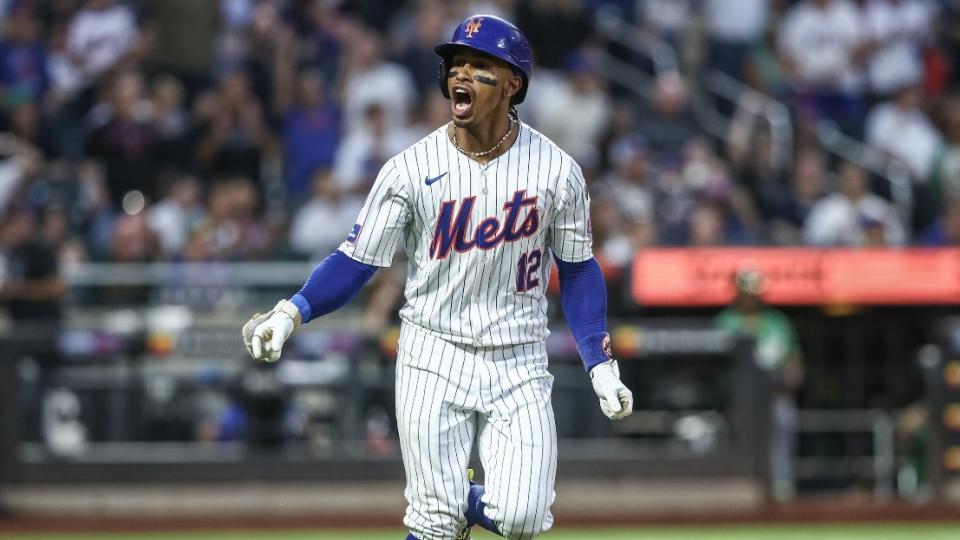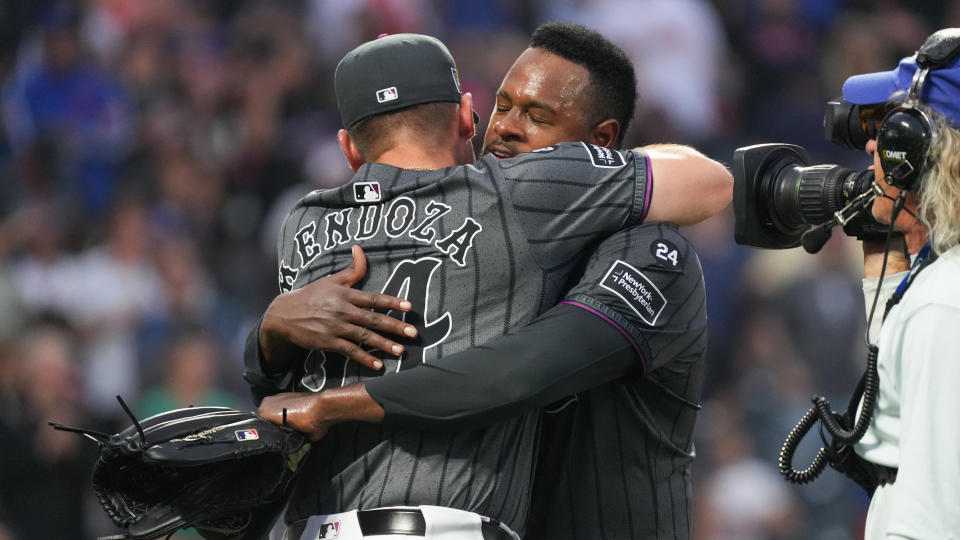Carlos Mendoza has been largely great during his first season managing the Mets, which also happens to be his first season managing in Major League Baseball.
The team ebbed and then flowed, turning a very tough start around and producing an incredibly fun season in Queens to this point that has spawned the Grimace and “OMG” crazes, featured lots of frenzied, joyous nights at Citi Field with the team in playoff contention, and led to David Stearns lightly buying at the deadline (after almost everyone on the planet predicted earlier this season that the Mets would sell).
Along the way, Mendoza has handled pretty much everything with aplomb.
One of the biggest responsibilities for a manager, especially in the New York market, is navigating the media and being the front-facing person for the organization twice daily during game days.
In that respect, Mendoza has been terrific.
He has also been great regarding communication with his players, and has put his money where his mouth is when it comes to fostering relationships with those players and trusting them.
One recent example? Allowing Luis Severino to finish Saturday’s masterful shutout after a quick ninth-inning mound visit, and the on-field hug the pitcher and manager shared when it was over.

When it comes to in-game moves, Mendoza — who has been up against it at times roster-wise this season, especially with his bullpen personnel — has made mostly sound decisions, and has also not shied away from being aggressive.
He hasn’t hesitated to make big moves when needed, including major lineup reshuffling — one of which led to a then-struggling Pete Alonso being dropped to fifth.
With all of that said, it hasn’t been the best last week or so for Mendoza. And with the Mets fighting for a playoff spot and struggling to beat subpar teams at home, those moves were magnified.
Below, we’ll analyze the two most critical decisions that did not work out, and two others that were also head-scratchers.
Thursday against Athletics: Mendoza uses Francisco Alvarez to pinch-hit for Jeff McNeil
With the Mets trailing the A’s, 7-6, Tyrone Taylor singled with one out in the seventh inning before stealing second base. Jose Iglesias then followed with an infield single, giving the Mets a prime chance to tie the game or take the lead.
McNeil, who was the Mets’ hottest hitter and was coming off two long, impressive at-bats earlier in the game, was due up against lefty reliever Scott Alexander.
But Mendoza pulled McNeil back and pinch-hit with Alvarez, who had hit a few balls well in the game prior but was mired in a prolonged slump.

Alvarez hit a dribbler at home plate that he unintentionally stepped into, and was called out. The next batter, Luis Torrens, lined out to shortstop to end New York’s threat.
After the game, Mendoza said he wanted the lefty-righty matchup, which is fair enough.
But the whole “handedness” thing is overblown, especially in the case of McNeil, who has a .290 average and .354 OBP for his career against lefties. That batting average is identical to how he’s fared against righties, and his OBP against lefties is a tick better (.354 to .352). His slugging percentage against righties is better, though — .450 compared to .387.
Sunday against Marlins: Mendoza has McNeil bunt in the ninth inning
Another huge situation, and another decision to take the bat out of McNeil’s hands.
With the Mets trailing the Marlins, 3-2, they had runners on first and second with no one out. And up came McNeil.
It made no sense to ask McNeil, who remained hot, to bunt there. In truth, it almost never makes sense to bunt.
The best case scenario there would’ve meant giving up an out and having one shot to tie the game without getting a hit. And even if McNeil succeeded, the Marlins would’ve almost certainly walked the scorching-hot Francisco Lindor with first base open.
What made things even worse was that after McNeil popped up his first attempt, nearly fouling out to third base, the bunt remained on for the next pitch. McNeil then watched a center-cut fastball to fall into an 0-2 count before striking out swinging.
Lindor followed by ripping a fly out to deep center that nearly got over the center fielder’s head, but remember: Lindor would’ve had the bat taken out of his hands if McNeil succeeded.

Mark Vientos, who likely would’ve been up with the bases loaded and one out had McNeil gotten the bunt down, batted after Lindor’s fly out and struck out to end the game.
After the game, Mendoza explained the choice to bunt, saying he was “just taking a chance trying to put two guys in scoring position there with the two best hitters” coming up.
The issue, of course, is that Lindor almost certainly wouldn’t have gotten the chance to swing the bat had McNeil’s bunt succeeded.
***
In addition to the two moves discussed above, there were two others that flew under the radar a bit.
One was not using Edwin Diaz in a tie game with two outs in the eighth inning on Sunday.
Diaz has pitched just twice since Aug. 7 and only four times this month, but was not called on and/or not ready to enter with two outs in the eighth and runners on first and second. Instead, it was Phil Maton, who gave up what turned out to be the game-winning hit.
That situation screamed for Diaz, who could’ve conceivably pitched the ninth inning as well — unless he was unavailable for some reason.
The other curious move was using Jose Butto for 2.0 innings during the Mets’ blowout loss to the A’s last Tuesday.
Perhaps Butto simply needed the work, but using him there took him out of play for the next two games, and his presence would’ve been huge on Thursday when Jose Quintana blew a 5-0 lead in New York’s eventual loss.
***
Now, there are two huge caveats.
There are often things going on behind the scenes that we don’t know about, and that Mendoza should not disclose to reporters. Perhaps there was something that led to one of those moves or non-moves.
The second, and most important caveat, is that this is still largely on the players. Quintana needed to be better on Thursday, the bullpen needed to close the door on Sunday, and more offense was needed throughout these last two series.
But it’s still fair to note that some of Mendoza’s recent decisions put the Mets in a poor position during games they really needed to win.
EMEA Tribune is not involved in this news article, it is taken from our partners and or from the News Agencies. Copyright and Credit go to the News Agencies, email news@emeatribune.com Follow our WhatsApp verified Channel





